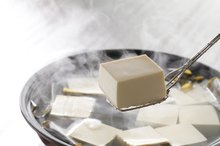Is a Red Rash on the Cheeks a Sign of a Food Allergy?
A red rash on the cheeks is a sign of an allergic reaction. Most food allergies will affect the skin and commonly develop a rash on the face before spreading to other parts of the body. If you suspect that you have a food allergy, talk with your doctor about allergy testing 1. If you don’t know which foods are triggering the reaction, you may eat the allergen without knowing it. Some food allergies can cause life-threatening conditions.
If you are experiencing serious medical symptoms, seek emergency treatment immediately.
Food Allergy
A food allergy occurs more in children than adults but can affect you at any age 1. After eating a food that you’re allergic to, your body will react as if it were under attack. The body creates various chemicals to ward off the suspected intruding substance. The chemicals that are produced cause inflammation in soft tissue, such as in the intestines, the respiratory system and the skin. Most symptoms develop within a few minutes after eating the allergic food.
- A food allergy occurs more in children than adults but can affect you at any age 1.
- After eating a food that you’re allergic to, your body will react as if it were under attack.
Rashes
Numbness in My Mouth After Eating
Learn More
Rashes are common with food allergies. The two most common rashes that can develop on your cheeks are hives and eczema. Hives can develop on anyone’s face, while eczema is a pre-existing skin condition. If hives develop on your cheeks they will slowly migrate to other parts of your face and body. Hives appear as welts and are very itchy and red. They are typically harmless, unless they form in your inner ear or throat. Eczema is a chronic skin condition that can be triggered by a food allergy 1. Eczema on your cheeks will develop as blisters that weep and crust over. They are itchy and will spread when scratched.
- Rashes are common with food allergies.
- Hives can develop on anyone’s face, while eczema is a pre-existing skin condition.
Other Symptoms
Food allergies will not just cause a rash on your cheeks, but will cause various symptoms to develop. Not everyone develops the same symptoms or to the same severity. The most common symptoms from a food allergy include:
- shortness of breath
- wheezing
- chest pain
- coughing
- diarrhea
- nausea
- vomiting
- abdominal pain
- cramping
- nasal congestion
- sneezing
- a runny nose 1
Anaphylaxis
Clementine Allergy
Learn More
In rare cases, a food allergy can cause anaphylaxis, a severe, life-threatening allergic reaction 1. Hives on the face are a common sign of anaphylaxis if hives is accompanied with facial swelling and an increased heart rate. If you notice these symptoms forming, call 911 for emergency attention.
Related Articles
References
- Mayo Clinic: Food Allergy
- University of Maryland Medical Center: Food Allergy
- American College of Allergy, Asthma & Immunology. Food Allergy.
- American College of Allergy, Asthma & Immunology. Hives (Urticaria). Updated June 11, 2018.
- American Academy of Allergy, Asthma & Immunology. Eczema (Atopic Dermatitis) Overview.
- KidsHealth. The Nemours Foundation. Eczema (Atopic Dermatitis). Updated September 2019.
- American College of Allergy, Asthma & Immunology. Eye Allergies.
- Cleveland Clinic. Urticaria (Hives) and Angioedema. Updated January 15, 2014.
- American Academy of Allergy, Asthma & Immunology. Food Intolerance Versus Food Allergy.
Writer Bio
Diane Marks started her writing career in 2010 and has been in health care administration for more than 30 years. She holds a registered nurse license from Citizens General Hospital School of Nursing, a Bachelor of Arts in health care education from California University of Pennsylvania and a Master of Science in health administration from the University of Pittsburgh.









